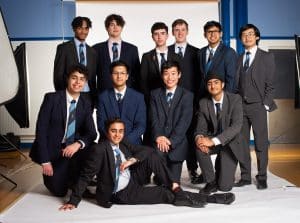A diverse and inclusive curriculum at Queen Elizabeth’s School: our vision
We are proud of the diversity of our School community, which comprises boys from a wide variety of backgrounds. Accordingly, we wish to offer a broad, inclusive and diverse curriculum. The vision statement below sets out principles by which this is being achieved.
Representing
 Our curriculum reflects and champions our diverse community, and our students generally feel it positively represents them. The curriculum’s taught content features a thoughtfully compiled and inclusive amalgam of voices and narratives, including the work of diverse authors and academics. While our aspiration is that students will see themselves in this content, we recognise that issues of identification and identity are complex, with diversity occurring within social groups as different aspects intersect. The curriculum therefore helps all students gain an understanding of this complexity and reflect on their own identity. Should students at times still feel that they have been excluded or marginalised, the curriculum provides them with opportunities to speak up.
Our curriculum reflects and champions our diverse community, and our students generally feel it positively represents them. The curriculum’s taught content features a thoughtfully compiled and inclusive amalgam of voices and narratives, including the work of diverse authors and academics. While our aspiration is that students will see themselves in this content, we recognise that issues of identification and identity are complex, with diversity occurring within social groups as different aspects intersect. The curriculum therefore helps all students gain an understanding of this complexity and reflect on their own identity. Should students at times still feel that they have been excluded or marginalised, the curriculum provides them with opportunities to speak up.
Understanding
The curriculum encourages students to think critically about knowledge in different subjects, exploring how knowledge is produced, how it comes to be valued, and, where necessary, what the connection is between knowledge and power. In evaluating the current curriculum, our focus is on understanding how and why certain individuals or groups have dominated the narrative, and the implications of that. The curriculum helps students to understand that even if contributions to knowledge in a particular discipline have hitherto been dominated by those with whom they do not identify, they should not reject that discipline. Instead, the curriculum encourages them to recognise that contributors now come from diverse groups. Where possible, the students themselves contribute to that knowledge. The curriculum fosters an understanding of prejudice and discrimination as structural and institutional issues, not just interpersonal problems. There is a focus on particular prejudices that might be present here, such as academic prejudice among the students.
Listening
 The curriculum allows space for students to talk about their identity and experience, and about the history, experiences and perspectives of their communities. Where appropriate, this is explicitly encouraged. For example, when setting a brief in the creative arts or technology, teachers reassure students that the boundaries of the required work are sufficiently broad that they can express themselves without fear of censure or losing marks. Our classroom culture encourages students to share experiences and express difference, so that each student encounters a diversity of views and learns that not all issues are clear-cut. When considering adding content to the curriculum, teachers include talking to students as part of their research.
The curriculum allows space for students to talk about their identity and experience, and about the history, experiences and perspectives of their communities. Where appropriate, this is explicitly encouraged. For example, when setting a brief in the creative arts or technology, teachers reassure students that the boundaries of the required work are sufficiently broad that they can express themselves without fear of censure or losing marks. Our classroom culture encourages students to share experiences and express difference, so that each student encounters a diversity of views and learns that not all issues are clear-cut. When considering adding content to the curriculum, teachers include talking to students as part of their research.
Equipping
The curriculum enables students to explore their own unconscious biases. It also develops empathy as students consider questions such as ‘Why might someone have this view?’ and ‘Why might someone behave in this way?’ and it gives them the language they need to discuss issues of diversity and inclusion without unwittingly causing offence. The curriculum teaches students how to challenge apathy when they encounter prejudice and discrimination, it promotes civic engagement within our community, discouraging passivity and instead guiding students towards taking action appropriate to each situation. It also prepares them for life beyond QE, including university, by equipping them with the intellectual, social and emotional tools to deal with any prejudice or discrimination they might face. Leaders and other teachers who plan and deliver the curriculum are committed to its ongoing evaluation, review and improvement. To equip them with the knowledge, skills and confidence to do this, they undertake training and professional dialogue.
